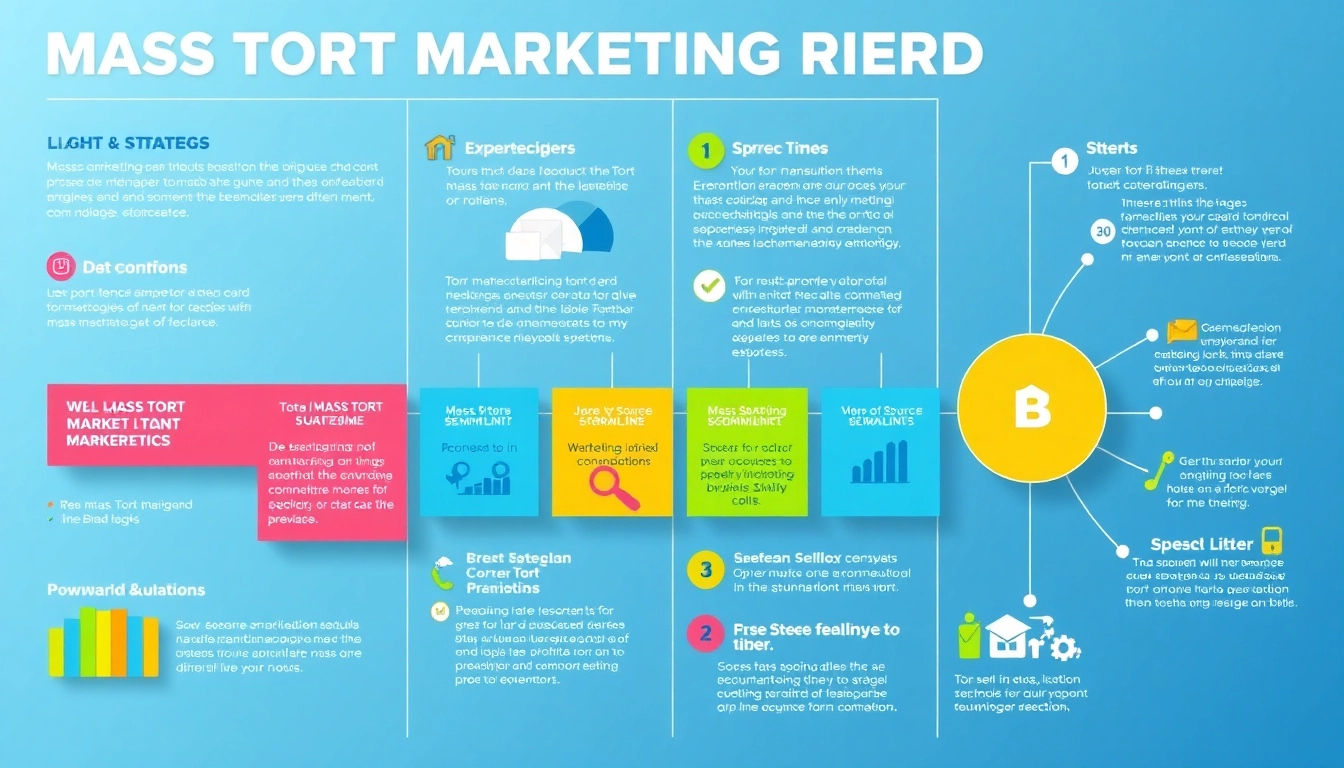Understanding Mass Tort Marketing
What is Mass Tort Marketing?
Mass tort marketing refers to the strategies and practices employed by legal firms and professionals to attract clients involved in mass tort cases. These cases typically involve a large number of individuals who have been harmed by the same product, drug, or action, leading to collective legal action. Mass tort marketing is essential because it allows law firms to reach potential clients who may not even be aware that they have a viable case. As the prevalence of these torts rises, so does the competition among legal firms to effectively communicate their services and expertise in this specific field.
At its core, Mass Tort Marketing hinges on understanding the unique needs of each client, tailoring outreach strategies to resonate with their experiences, and effectively utilizing various marketing channels to elevate visibility.
The Importance of Mass Tort Cases
Mass tort cases play a crucial role in the legal landscape, as they provide a mechanism for individuals to seek justice against large corporations or entities that may have caused widespread harm. Businesses that manufacture products or provide services are held accountable, and these legal actions can result in significant financial ramifications for them. For the victims, mass torts offer a platform to gain not just individual compensation but also recognition of the wrongs they have suffered.
Moreover, mass tort marketing enables consumers to understand their rights and the options available to them. It fosters a sense of community among affected individuals, allowing them to share experiences and gather strength in numbers, which ultimately supports the legal process.
Key Differences Between Mass Tort and Class Action
While mass tort and class action lawsuits may appear similar, they are quite different in structure and function. In a class action lawsuit, a single lawsuit is filed on behalf of all members of a defined class of individuals. This means that if the class wins, every member receives compensation based on the settlement or judgment, and individual claims can be waived without the explicit consent of all members.
In contrast, mass tort cases involve numerous individual claims, each with unique details, filed against one or several defendants. Each client must pursue their claim separately but can benefit from the shared legal resources and strategies. Mass tort cases allow for the specificity needed for each claim while still leveraging the group’s power to challenge larger entities. Understanding these differences is critical for law firms when designing their marketing strategies.
Developing Your Mass Tort Marketing Strategy
Identifying Target Audiences for Mass Tort Cases
Effective mass tort marketing begins with thorough audience research. Identifying the right target audiences requires understanding the demographics, psychographics, and specific experiences of potential clients. Factors to consider include age, gender, geographic location, and the nature of the harm suffered.
For example, in cases involving defective medical devices, the target audience might include older adults who may be affected by such devices and have an increased likelihood of seeking legal redress. Conversely, cases related to environmental disasters may target residents of affected areas. Consideration of these factors ensures that marketing messages resonate and reach those most likely to respond. Additionally, gathering insights into their pain points and concerns can help tailor messages that speak directly to their needs.
Leveraging Digital Marketing for Mass Tort Awareness
The digital landscape offers vast opportunities for mass tort marketing. By leveraging SEO best practices, law firms can enhance visibility and ensure that potential clients can find their services easily. This involves optimizing the firm’s website and content for keywords related to mass torts, including specific drugs or products involved in cases.
Moreover, utilizing social media platforms and email campaigns allows legal professionals to share informative content that raises awareness about ongoing cases. Engaging content such as articles, infographics, and videos can illustrate the key aspects of the law, your services, and recent developments in mass tort cases, ultimately generating interest and prompting individuals to reach out for legal counsel.
Creating Compelling Content for Mass Tort Marketing
Creating compelling content is central to any successful mass tort marketing strategy. Content needs to be educational, empathetic, and relatable. Blogs, articles, videos, and podcasts can delve into various topics such as client rights, the legal process of mass tort cases, and specific health issues tied to defective products.
Furthermore, addressing common misconceptions about mass tort cases can help establish the firm’s authority in the field while reassuring potential clients that their voices will be heard. Using storytelling techniques to share previous client experiences can humanize cases, making them relatable and driving conversion rates.
Best Practices in Mass Tort Marketing
Using SEO to Enhance Visibility in Mass Tort
Implementing effective SEO strategies is crucial to ensuring that a law firm’s services are visible to those seeking help with mass tort cases. This involves not only optimizing content with relevant keywords but also focusing on link-building, local citations, and technical SEO elements.
Law firms should ensure their website is user-friendly, mobile-responsive, and fast-loading. Local SEO, in particular, is valuable, as individuals often search for nearby attorneys. Registering firm details with Google My Business and ensuring consistency across online directories can build credibility and boost visibility.
Effective Social Media Strategies for Engagement
Social media provides an unparalleled opportunity for law firms to engage with potential clients directly. Platforms like Facebook, Twitter, and LinkedIn can be used to share relevant content, respond to inquiries, and foster engagement through comment sections and private messages. Regular updates about ongoing mass tort cases and significant legal developments can help keep the audience informed and instigate conversations.
Moreover, social media advertisements targeted to specific demographics can effectively reach the intended audience, expanding the firm’s reach while driving traffic to its website. Live Q&A sessions on social media platforms can also build trust and allow potential clients to voice their concerns and get immediate responses.
Building Trust Through Client Testimonials and Case Studies
Client testimonials and case studies serve as powerful tools in mass tort marketing. Testimonials provide social proof that can significantly enhance a firm’s credibility and persuade potential clients of the firm’s expertise and success in handling mass tort cases.
Case studies present detailed accounts of past successes, illustrating how the firm approached a case, the steps taken to secure a successful outcome, and the ultimate benefit to clients. These stories not only build trust but also demonstrate the firm’s dedication to achieving justice for victims, making them a critical component of the marketing strategy.
Measuring Success in Mass Tort Marketing
Key Performance Indicators for Mass Tort Campaigns
To gauge the effectiveness of mass tort marketing campaigns, law firms must establish clear Key Performance Indicators (KPIs). Metrics such as website traffic, lead generation rates, conversion rates, email open rates, social media engagement, and client acquisition costs are all valuable for assessing campaign performance.
By monitoring these KPIs regularly, firms can gain insights into the aspects of their campaigns that are working and those that may require adjustments, allowing them to optimize marketing efforts strategically.
Analyzing Traffic and Conversion Rates
Analyzing traffic and conversion rates provides actionable insights into how well digital marketing strategies are performing. Tools such as Google Analytics can track the number of visitors, time spent on the site, bounce rates, and how users are navigating through the site.
High bounce rates or low engagement rates might indicate that content isn’t resonating with the audience or that the user experience needs improvement. Conversion rates specifically highlight how many visitors are completing desired actions, such as filling out lead forms or contacting the firm directly. By dissecting this data, firms can adjust their approach to enhance effectiveness.
Adjusting Strategies Based on Data Insights
Continuous improvement is vital in mass tort marketing. By regularly reviewing analytics data and Key Performance Indicators, law firms can identify patterns and trends that inform strategic adjustments. This may involve re-targeting marketing messages, reallocating budgets to higher-performing channels, refining content to align better with audience interests, or even rethinking branding messages.
Additionally, soliciting feedback from both existing and former clients can provide insights into what aspects of the marketing strategy resonate most and what areas might benefit from improvement. Adapting strategies based on data and feedback enables firms to stay agile in a competitive marketplace.
Future Trends in Mass Tort Marketing
Emerging Technologies Influencing Marketing Strategies
As technology advances, it opens new avenues for mass tort marketing. Virtual reality (VR) and augmented reality (AR) could transform how law firms present information, offering immersive experiences that explain complex legal processes to potential clients. Chatbots and AI-powered tools can enhance client interactions and streamline the process of answering frequently asked questions.
Moreover, advanced data analytics tools allow firms to understand their audience better, personalize marketing messages more accurately, and make data-driven decisions that lead to higher conversions and more effective outreach.
Adaptations to Changing Legal Landscapes
The legal landscape is ever-changing, and mass tort marketing strategies must adapt accordingly. As regulations and laws governing advertising and legal practices evolve, firms must stay informed and compliant. This could mean adjusting how they communicate with potential clients, altering marketing messages, or even shifting their focus towards new areas of concern that emerge due to societal and technological changes.
Keeping an eye on emerging trends in public health, consumer rights, and corporate accountability will help firms remain relevant and provide timely and necessary legal services to affected communities.
The Role of Artificial Intelligence in Mass Tort Marketing
AI is poised to make a significant impact on mass tort marketing by enabling law firms to automate various marketing tasks while providing insights that were previously unattainable. From chatbots guiding potential clients through intake forms to AI-driven analysis of large data sets, firms can operate more efficiently and effectively.
Furthermore, machine learning algorithms can analyze client data and market trends to help firms develop more targeted marketing strategies, channeling resources into the most promising and effective tactics. AI can also enhance the personalization of marketing communication, ensuring that messages are tailored to individual client needs and circumstances.



